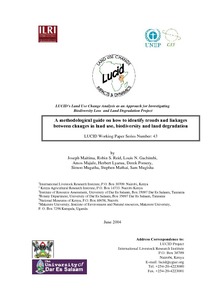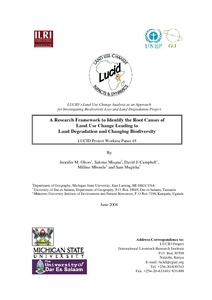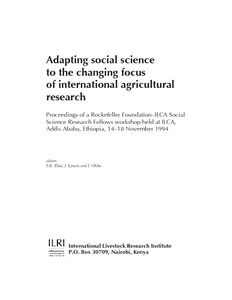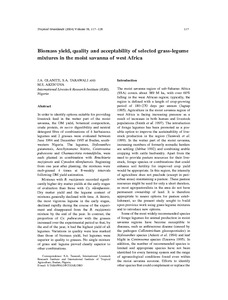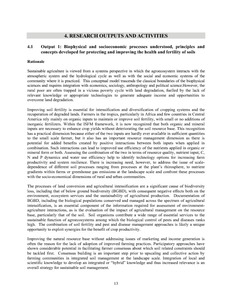Collective action and property rights for sustainable development
Institutions of collective action and systems of property rights shape how people use natural resources, and these patterns of use in turn affect the outcomes of people’s agricultural production systems. Together, mechanisms of collective action and property rights define the incentives people face for undertaking sustainable and productive management strategies, and they affect the level and distribution of benefits from natural resources.
Acción colectiva y derechos de propiedad para el desarrollo sostenible
Las instituciones de acción colectiva y los sistemas de derechos de propiedad moldean la forma en que la gente usa los recursos naturales.A su vez, estos patrones de uso afectan los resultados de los sistemas de producción agrícola de la gente. Juntos, los mecanismos de acción colectiva y los sistemas de derechos de propiedad definen los incentivos a los que la gente accede por llevar a cabo estrategias de gestión sostenible y productiva, y afectan el nivel y distribución de los beneficios de los recursos naturales.
Building on successes in African agriculture
Agricultural growth will prove essential for improving the welfare of the vast majority of Africa’s poor. Roughly 80 percent of the continent’s poor live in rural areas, and even those who do not will depend heavily on increasing agricultural productivity to lift them out of poverty. Seventy percent of all Africans— and nearly 90 percent of the poor—work primarily in agriculture. As consumers, all of Africa’s poor—both urban and rural—count heavily on the efficiency of the continent’s farmers.
Spatiotemporal mapping of the dry season vegetation response of sagebrush steppe
The vegetation dynamics of semi-arid and arid landscapes are temporally and spatially heterogeneous and subject to various disturbance regimes that act on decadal scales. Traditional field-based monitoring methods have failed to sample adequately in time and space in order to capture this heterogeneity and thus lack the spatial extent and the long-term continuous time series of data necessary to detect anomalous dynamics in landscape behavior.
Abomasal parasites in wild sympatric cervids, red deer, Cervus elaphus and fallow deer, Dama dama, from three localities across central and western Spain: relationship to host density and park management
A survey of abomasal parasites in cervids from Central Spain was conducted at 3 sites, Quintos de Mora (Toledo), Maluéñez de Arriba (Cáceres), and La Herguijuela (Cáceres). Commonly occurring helminths belonged to 3 polymorphic species of the Ostertagiinae: Spiculopteragia asymmetrica/S. quadrispiculata, Ostertagia leptospicularis/O. kolchida, and O. drozdzi/O. ryjikovi. Trichostrongylus axei was found in very few cases. Ostertagia drozdzi/O. ryjikovi and the minor male morphotype, S. quadrispiculata, are reported for the first time in red deer from Spain.
influence of land use on desertification processes
Site degradation occurs mainly through deterioration of the soil's capacity to capture and store water, as well as the loss of organic matter or the accumulation of salts or other toxic substances in the soil. This degradation process, leading to the reduction of the biotic potential of the site, is known as desertification. In this study, changes in bulk density, organic matter, and electrical conductivity are used as indicators of desertification in northeast Mexico.
A research framework to identify the root causes of land use change leading to land degradation and changing biodiversity
Adapting social science to the changing focus of international agricultural research. Proceedings of a Rockefeller Foundation-ILCA social science research fellows workshop
The papers in this proceedings provide a cross section of science research in international agricultural research centres (IARCs), where the objectives and research foci within the Consultative Group on International Agricultural Research (CGIAR) have changed substantially in the 1990s. The book is divided in five sections. The first explores priority setting and research evaluation of commodity programmes. The second looks at institutional issues. The third explores issues related to commodity policies and food security.
Biomass yield, quality and acceptability of selected grass-legume mixtures in the moist savanna of West Africa
In order to identify options suitable for providing livestock feed in the wetter part of the moist savanna, the DM yield, botanical composition, crude protein, in sacco digestibility and neutral detergent fibre of combinations of 4 herbaceous legumes and 2 grasses were evaluated between June 1994 and December 1995 at Ibadan, south-western Nigeria. The legumes, Stylosanthes guianensis, Aeschynomene histrix, Centrosema pubescens and Chamaecrista rotundifolia, were each planted in combination with Brachiaria ruziziensis and Cynodon nlemfuensis.






